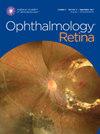Pneumatic Retinopexy for Rhegmatogenous Retinal Detachment Outcomes
IF 4.4
Q1 OPHTHALMOLOGY
引用次数: 0
Abstract
Purpose
To determine treatment patterns and outcomes of pneumatic retinopexy (PnR) for rhegmatogenous retinal detachments (RRDs).
Design
Retrospective cohort analysis using IRIS® Registry (Intelligent Research in Sight) database.
Participants
Patients with RRD treated by PnR from 2013 to 2022.
Methods
Cases were identified using International Classification of Diseases, Ninth and Tenth Revisions, diagnostic codes. Surgical procedures were identified using Current Procedural Terminology codes for type of RRD repair. Baseline demographic information included age, sex, race and ethnicity, geographic region, smoking status, and health insurance type.
Main Outcome Measures
Primary outcomes for PnR included single-operation success (SOS) and single-operation failure (SOF), change in visual acuity at 9 to 12 months, rates of complications, rates of secondary procedure after SOF, and outcome by phakic status.
Results
A total of 13 302 unique eyes were analyzed (median age, 64 years; 61.56% male). Overall SOS for primary PnR was 59.82%. The mean best-corrected visual acuity at 9 to 12 months after PnR was logarithm of the minimum angle of resolution 0.44 (95% confidence interval, 0.42–0.46) for SOF eyes, compared with 0.23 (95% confidence interval, 0.22–0.25) for SOS eyes (P < 0.001). Complications of PR included vitreous hemorrhage (9.1%), epiretinal membrane (45.17%), proliferative vitreoretinopathy (0.98%), and endophthalmitis (0.14%). Of the 40.18% of eyes with SOF, 81% required either secondary PnR, scleral buckle, vitrectomy, or complex detachment repair, whereas the remaining eyes required more than one of these secondary procedures. Single-operation success for phakic eyes was 64.50% versus 53.93% for pseudophakic eyes (P < 0.001).
Conclusions
IRIS Registry data reveal clinical outcomes and utilization patterns of PnR for RRD. Overall SOS for primary PnR was 59.82%, which is lower than other cited rates in the literature. Pseudophakic eyes were more likely to fail primary PnR. It is important to counsel patients on risks of the procedure when obtaining informed consent.
Financial Disclosure(s)
Proprietary or commercial disclosure may be found in the Footnotes and Disclosures at the end of this article.
气动视网膜剥离术治疗风湿性视网膜脱离的疗效:IRIS® Registry (Intelligent Research in Sight) 分析。
目的:确定流变性视网膜脱离(RRD)的气压性视网膜剥离术(PnR)的治疗模式和效果:利用IRIS® Registry(Intelligent Research in Sight)数据库进行回顾性队列分析:2013-2022年期间接受PnR治疗的RRD患者:使用国际疾病分类第九版和第十版修订版(ICD-9、ICD-10)诊断代码确定病例。使用当前程序术语(CPT)代码确定 RRD 修复类型的手术程序。基线人口统计学信息包括年龄、性别、种族和民族、地理区域、吸烟状况和医疗保险类型:PnR的主要结果包括单次手术成功(SOS)和失败(SOF)、9-12个月时视力的变化、并发症发生率、SOF后二次手术的发生率,以及根据隐形状态得出的结果:共分析了 13302 只眼球(中位年龄 64 岁,61.56% 为男性)。初次 PnR 的总体 SOS 为 59.82%。PR 后 9-12 个月时,SOF 眼睛的平均 BCVA 为 0.44(95% CI:0.42, 0.46),而 SOS 眼睛的平均 BCVA 为 0.23(95% CI:0.22, 0.25)(P < 0.001)。PR的并发症包括玻璃体出血(9.1%)、ERM(45.17%)、增殖性玻璃体视网膜病变(0.98%)和眼底病(0.14%)。在 40.18% 的 SOF 眼睛中,81% 需要进行二次 PnR、巩膜扣带术 (SB)、玻璃体切除术 (VTX) 或复杂脱落修复术 (CDR),而其余的眼睛则需要进行上述一种以上的二次手术。晶状体眼的SOS为64.50%,而假性晶状体眼为53.93%(P < 0.001):IRIS登记数据揭示了真实世界中PnR治疗RRD的结果和使用模式。原发性 PnR 的总体 SOS 为 59.82%,低于文献中引用的其他比率。假性角膜病变的眼睛更有可能无法通过初级 PnR。在获得知情同意时,向患者说明手术风险非常重要。
本文章由计算机程序翻译,如有差异,请以英文原文为准。
求助全文
约1分钟内获得全文
求助全文

 求助内容:
求助内容: 应助结果提醒方式:
应助结果提醒方式:


